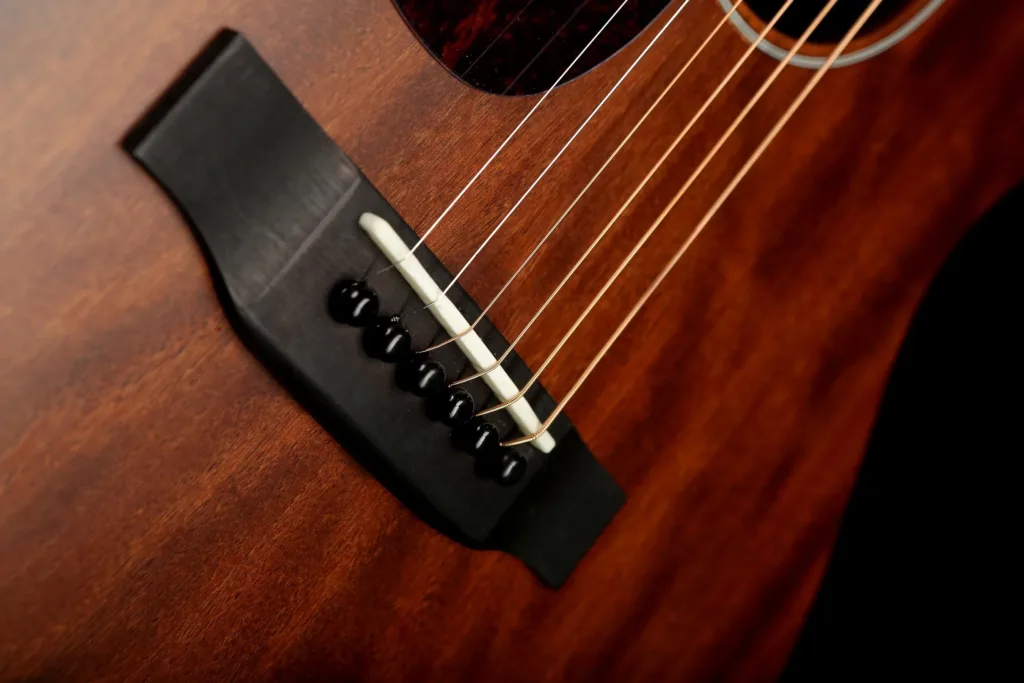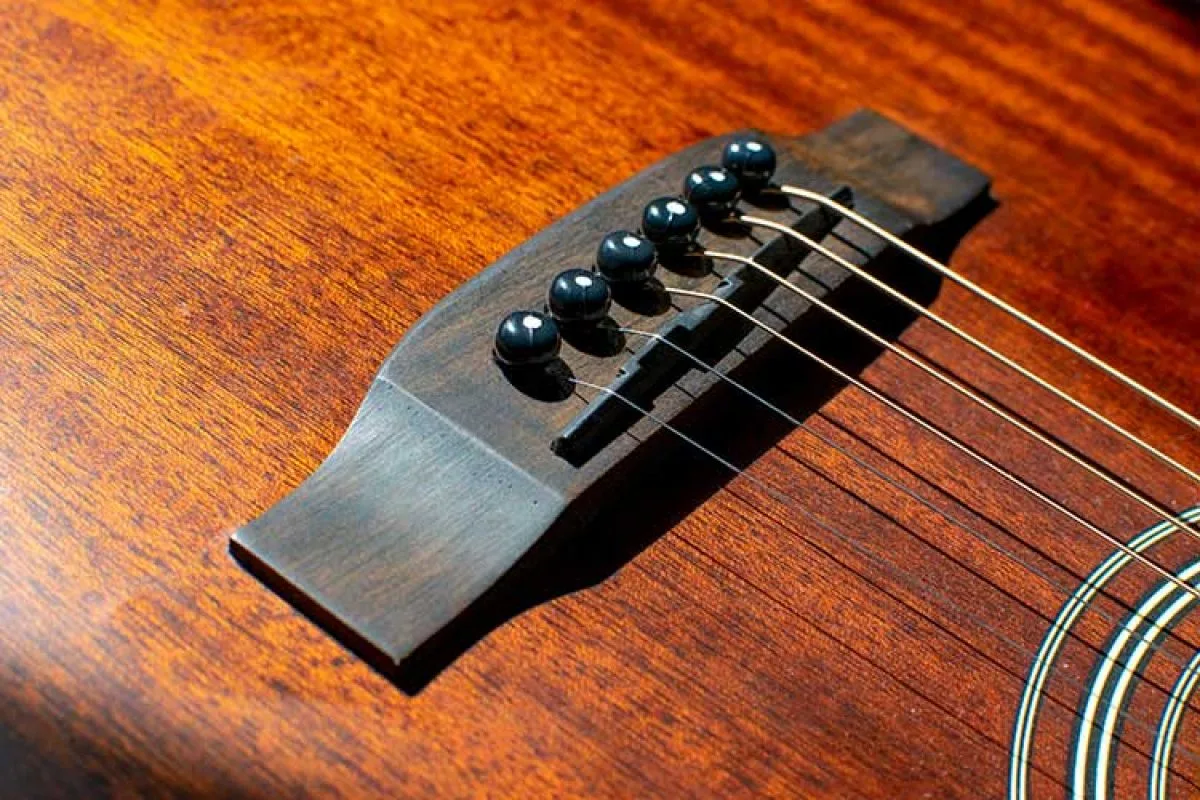Have you ever wondered what that small piece of bone or plastic is on the bridge of your guitar? Yes, we’re talking about the saddle. For beginners, it may seem like just another insignificant part, but don’t be fooled! The saddle serves an essential purpose in producing beautiful music from your guitar. In this article, I’ll guide you through everything you need to know about the saddle on a guitar- its function, materials used, and how it affects your playing experience. By understanding this often overlooked component, you’ll have a better appreciation for your instrument and be able to make informed decisions when it comes time for maintenance or upgrades. So let’s dive into this fascinating topic together!
So, what is the saddle on a guitar?
The saddle on a guitar is a small component located at the bottom of the bridge, where the strings are held in place. It serves as an important point of contact between the strings and the body of the guitar, helping to transmit vibrations and create sound. The material and shape of the saddle can greatly affect the tone and playability of a guitar. Some common materials for saddles include bone, plastic, and metal. Proper placement and adjustment of the saddle is crucial for maintaining good intonation (the accuracy of pitch) on a guitar. So next time you strum your favorite song, remember that tiny but mighty piece known as the saddle!
Understanding the Function of a Saddle on a Guitar
A guitar’s saddle may seem like a small, insignificant piece, but it plays a huge role in shaping the instrument’s sound. Positioned on the bridge, this slim strip of material works its magic by transferring vibrations from the strings to the body of the guitar. This transfer is what enables your favorite melodies to resonate with clarity and depth. Made from materials such as bone, plastic, or synthetic compounds, each type brings out different tonal qualities in your music. For instance, bone saddles are often praised for their ability to produce richer tones compared to their plastic counterparts.
The height and placement of this tiny component can also dramatically impact playability and sound quality. A well-adjusted saddle ensures that each string maintains proper intonation, which means every note rings true up and down the fretboard. Misalignment here can lead to frustrating tuning issues or even uncomfortable playing experiences due to poor action (the distance between strings and fretboard). Adjusting it requires delicate precision; too high can make pressing strings difficult while too low might cause unwanted buzzing sounds when you strum.
- Material: Bone vs Plastic vs Synthetic
- Height: Impacts action
- Tuning: Ensures intonation
In essence, though it’s small in size, never underestimate its importance in bringing your musical expressions to life.
Different Types of Materials Used for Guitar Saddles and Their Effects
Guitar saddles might seem like small, insignificant parts of an instrument, but they play a crucial role in the overall sound and performance. Bone is one of the most traditional materials used for guitar saddles. It’s often favored by musicians because it provides a rich tone with excellent sustain. The density of bone allows it to transmit string vibrations efficiently, producing clear and balanced harmonics. Another advantage is its durability; bone can withstand years of playing without degrading significantly.
On the other hand, modern players sometimes opt for synthentic materials such as Tusq or Micarta. These synthetic options mimic some qualities of natural bone but offer more consistency since they are factory-made. Tusq saddles provide a bright tone with increased clarity and volume which makes them popular among electric guitarists looking for that extra edge in their sound.
- Plastic: Often found on beginner guitars due to cost-effectiveness, but tends to wear out quickly.
- Brass: Adds sustain and brightness but can be heavy.
- Ceramic: Offers unique tonal characteristics that some niche players prefer.
Choosing the right saddle material depends on personal preference and musical style. Each has distinct properties affecting tone quality, projection, and longevity.
The choice ultimately impacts how your guitar feels under your fingers—a subtle yet profound difference every player should explore!
Read also: yamaha guitar semi hollow
The Role of the Saddle in Determining Guitar String Action and Intonation
The saddle is a small yet crucial part of a guitar, often overlooked by beginners. It directly impacts both the string action and intonation, which are key to getting that perfect sound. String action, or how high the strings are from the fretboard, can make playing feel like gliding on air or wrestling with steel rods. A well-shaped saddle keeps this just right. Too low? Your strings might buzz annoyingly against the frets. Too high? Playing becomes hard work for your fingers.
Intonation, on the other hand, ensures each note plays in tune up and down the neck of your guitar. The saddle’s position plays a big role here too. If it’s not properly adjusted, you might find yourself constantly out of tune no matter how much you tweak those tuning pegs!
To get it spot-on:
- Check if your notes ring true at both open string positions and twelfth fret harmonics.
- Make slight adjustments to move the saddle forward or backward as needed.
A fine-tuned saddle works wonders in keeping everything balanced and harmonious.
So when you’re next strumming away happily on your guitar, take a moment to appreciate that tiny but mighty piece sitting under your strings—they owe their smooth playability and spot-on pitch largely to its dedicated job!

Maintaining and Replacing the Saddle: Guidelines for Guitar Players
When it comes to keeping your guitar in top-notch condition, the saddle is one of those often-overlooked components that can significantly influence sound quality. A well-maintained saddle ensures optimal string height and correct intonation, which are crucial for producing clear and accurate tones. Regular checks should be part of your routine—look for cracks or signs of wear that might affect performance. If you notice any issues, don’t delay in addressing them; a small problem now can turn into a major issue down the line.
Replacing the saddle isn’t as daunting as it sounds but requires some attention to detail. First, you’ll need to loosen the strings gently to avoid causing any damage while removing the old saddle. Once removed, compare its size and shape with potential replacements—getting an exact match is vital for maintaining proper action and tone.
When fitting a new saddle:
- Ensure it’s snug but not forcing.
- Avoid using glue unless absolutely necessary.
- Test different materials like bone or synthetic options to find what best complements your instrument’s sound.
Finally, retune your guitar carefully after installation; this helps settle everything back into place snugly so you can get right back to playing those sweet riffs without missing a beat!
You may also like: chickering upright piano
Conclusion: Appreciating the Importance of the Guitar’s Saddle
The humble guitar saddle may seem like a minor detail, but it plays an immense role in shaping the instrument’s sound. Nestled on the bridge, this small piece is where the strings rest before they travel over to the fretboard. It directly influences intonation, or how in-tune each note sounds along the neck of your guitar. When you strum a chord and hear that perfect harmony, thank the well-crafted saddle for ensuring those notes ring true.
Beyond intonation, the saddle affects string height or “action.” Too high and playing becomes strenuous; too low and you risk annoying buzzes from frets. A finely adjusted saddle provides just right balance between ease of play and clear tones.
Think about:
- The material—bone, plastic, or synthetic compounds all give different tonal qualities.
- The shape—whether flat or compensated impacts how well each string resonates.
All these elements profoundly impact not only playability but also your overall enjoyment when making music.
In essence, while it might be tucked away quietly beneath your fingers as you glide through tunes, the guitar’s saddle is indispensable.
It’s a testament to how vital even tiny components are within musical craftsmanship.
Understanding its importance helps players appreciate every meticulous detail that goes into creating beautiful melodies.
Acknowledging such aspects deepens our connection with our instruments.

